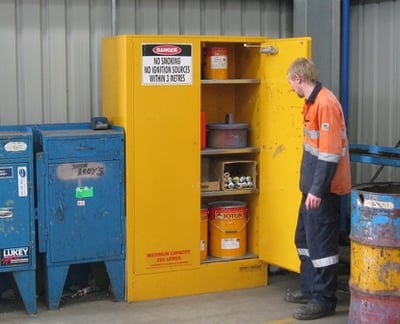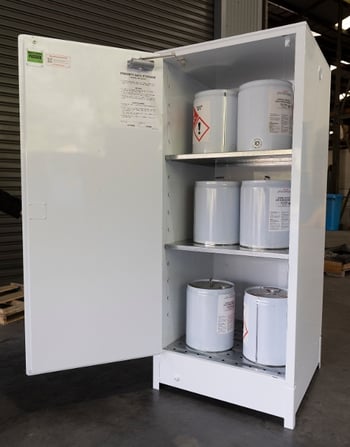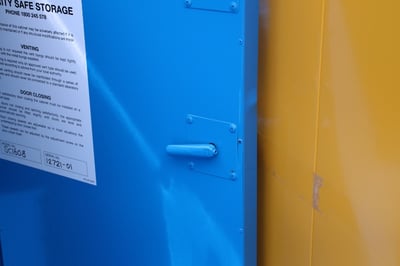Are there specific requirements that relate to the doors of a chemical cabinet? This post unlocks all the details that relate to the design and construction of chemical storage cabinet doors. As with any type of hazardous chemical store, there are requirements in place to ensure the safety and compliance of the facility. The Australian Standards provides us with specific construction details for each class of dangerous goods storage cabinet. While adhering to these requirements is part of your compliance obligations, it’s also important to understand why these construction features are in place — and how your staff should be using your cabinet doors.
The Design and Construction of Chemical Cabinet Doors
The specific requirements that relate to chemical storage cabinets are different for each class of dangerous goods. In the next section, we’ll detail the requirements that directly relate to the doors of each class of chemical cabinet.
Class 1 - Explosives
In Section 2.2.2 of AS 21871.1:1998 Explosives - Storage, transport and use, you’ll find the requirements that relate to internal portable magazines (ie storage cabinets).
These requirements include details for the design and construction of the doors and locks of an explosive cabinet.
Compliant cabinets, therefore, must be:
- Fitted with a close-fitting lid secured by a steel hasp, steel staple and steel hinges (if the magazine is storing gunpowder, copper or copper alloy (brass) shall be used)
- Fitted with a compliant lock
The reason these requirements are in place is to ensure security and protection for the Class 1 explosives within the cabinet. Steel is a strong, non-combustible metal which is ideal for the storage of explosives. Copper or copper alloy fittings are required for gunpowder as there is a reduced risk of the metal sparking.
Class 3 - Flammable Liquids
Section 4.9.2 of AS 1940:2017 – The storage and handling of flammable and combustible liquids explains that:
- Flammable cabinet doors must be self-closing and close-fitting
- Doors must be held shut automatically by catches at 2 or more points
Due to the volatility of flammable liquids, including their ability of ignite, explode and release flammable vapours, the requirements for flammable cabinet doors are strict. Doors need to be close-fitting to contain vapours, as well as offering adequate heat protection for stored substances. The heat barrier of the cabinet, along with the doors, allows for a 10-minute window of time whereby firefighting equipment can be activated and emergency evacuations can take place.

Your flammable cabinet is equipped with self-closing, close-fitting doors that shut automatically.
The self-closing mechanism of the door is required to reduce the likelihood of spillage and vapour emissions. As the doors of the cabinet are designed to close automatically, the risk of ignition and reactions with incompatible substances is minimised.
Class 4 - Flammable Solids
In Section 5.7.3 Cabinet design and construction, AS/NZS 5026:2012 – The storage and handling of class 4 dangerous goods details the requirements for flammable solid storage cabinet doors:
- Doors must be self-closing and close-fitting
- Cabinet doors must be held shut by either a friction-type or a magnetic-type lock, which is designed to release automatically
Similar to flammable liquid cabinets, the flammable solids storage cabinet must be constructed with self-closing, tight-fitting doors to contain vapours. The doors also offer a heat barrier for the stored chemicals, allowing for the safe evacuation of workplaces — and the notification of emergency services.
However, as a build-up of pressure within the cabinet can exacerbate the risk of explosion, the doors must be able to release under pressure. This is achieved through using a friction- or magnetic-type lock.
IMPORTANT: As flammable solids cabinets aren’t key locked, we recommend placing your storage cabinet within a secured area to reduce the risk of unauthorised entry.
Class 5.1 - Oxidizing Agents
In Section 4.8.3 Cabinet design and construction, AS 4326:2008 – The storage and handling of oxidizing agents explains the requirements for oxidizing agent storage cabinets.
The oxidizing agent cabinet must have one or more doors that are:
- Self-closing, close-fitting and held shut by catches that release if pressure builds up within the cabinet
- Door catches and hinges must not be constructed of plastics or zinc die castings
As chemicals which may contribute to the combustion of other material, oxidizing agents must be stored in cabinets which reduce the risk of dangerous reactions. This class of dangerous goods requires a protected environment for storage (hence the self-closing, close-fitting doors), but must not create a further risk by having doors which aren’t capable of opening in the event of a build-up of pressure within the storage space.
Door fittings should be constructed from chemically compatible materials that can withstand extreme temperatures in the event of a fire. Therefore, plastics or zinc die castings are prohibited in compliant oxidizing agent storage cabinets.
Class 5.2 - Organic Peroxides
Section 4.6.1 Cabinet design and construction offers the requirements for indoor storage cabinets. AS 2714:2008 – The storage and handling of organic peroxides states that:
- Organic peroxide cabinets shall be provided with a self-closing, close fitting door
- The door must be held shut by either a friction-type or a magnetic-type lock that can release if there is a pressure build-up within the cabinet
- Catches and hinges must not be constructed of plastic materials. Metal catches and hinges are acceptable
Organic peroxides are an unstable class of dangerous goods that are capable of combustion. If chemicals are subjected to high temperatures (or not properly segregated from incompatible substances), they can ignite and cause destructive fires and explosions.
Therefore, the storage cabinet for organic peroxides must be fitted with doors that offer protection from heat and other incompatible substances. These doors also assist with minimising the risk of organic peroxide spillage into the work area.
Due to the risk of explosion, cabinet doors must also be capable of automatic release if the pressure builds within the chemical storage space.
Class 6 - Toxic Substances
Within AS/NZS 4452-1997 – The storage and handling of toxic substances, you will find the construction details for a toxic substances storage cabinet. In Section 4.4.2.3 Cabinet design, the Standard explains that indoor chemical cabinets for the storage of Class 6 substances must feature:
- self-closing, close-fitting doors
- cabinets for the storage of toxic substances must be lockable
Due to the serious risk that toxic substances pose to human health and the environment, it’s crucial that the cabinet provides protection against spillage, theft, vandalism and general misuse.

Toxic cabinets must be constructed with lockable doors that are self-closing and tight-fitting.
The self-closing, close-fitting doors of the cabinet help in reducing the likelihood and impact of toxic vapour emissions and spillage. Having lockable doors assists with the control of the chemical inventory and dissuades unathorised entry to the chemical cabinet.
Class 8 - Corrosive Substances
Section 4.6 of AS 3780:2008 – The storage and handling of corrosive substances explains the requirements that specifically apply to indoor storage cabinets. These include the design of the cabinet which must include:
- A self-closing, close-fitting door which is held by catches at no less than 2 points
- The door of the cabinet must not open inwards; it must also be capable of being opened from the inside
Corrosive substances are capable of deteriorating living tissue, metal and other materials. Therefore, compliant storage is necessary if corrosives are to be handled and stored safely. Just like the other chemical cabinet classes highlighted above, corrosives must be stored in an indoor corrosive storage cabinet with self-closing, close-fitting doors. This feature assists with corrosive substance spillage and vapour containment, which can be harmful to both people and property.

Corrosive substance cabinets must be able to be opened from the inside.
Extra precautions for staff safety are written into the requirements for the cabinet, including that the door must only open outwards (reducing the risk of containers being knocked over and spilled). The cabinet must be able to be opened from the inside, to reduce the likelihood that a staff member could be trapped within.
Should You Keep The Chemical Cabinet Doors Open?
As we’ve detailed in this post, the self-closing doors of many classes of safety cabinets are a key risk control measure required by the Australian Standards.
While there are some circumstances where staff may require doors to be held open for a short time, while they access the chemicals within the cabinet, it’s imperative that the automatic door closing system is never inhibited. Therefore, make sure that the stored chemicals are stacked and loaded neatly, without the packages interfering with the self-closing mechanism of the cabinet.
You should also ensure that staff don’t prop open the doors of the cabinet, as this can damage the doors and increase the risk of spillage, vapour emissions, ignition and dangerous chemical reactions.
What Is The Safe-T-Closing System?
If you’re familiar with our dangerous goods storage site, you may have noticed our Safe-T-Close door close system in the cabinet features section. This patented system is unique to STOREMASTA and allows doors to sequentially close without jamming or slamming shut.
Our door close system is powered by a hydraulic mechanism which automatically closes the doors, smoothly and in sequence. This allows staff to use the cabinet without worrying that they have not properly closed the doors. The system, in turn, increases the effectiveness of the cabinet and reduces the risk of spillage, vapour emissions and ignition.
Can You Control The Speed Of The Door Closing System?
The door closing speed of your chemical cabinet can be easily adjusted to suit the needs of your staff. We highly recommend setting the speed of your doors upon cabinet installation —and adjusting it as you see fit. This allows your staff to operate the cabinet in a more comfortable and efficient manner.
To adjust the door closing speed simply turn the adjustment screw on the cabinet’s hydraulic door closer.
REMEMBER: The doors of your cabinet won’t work properly if the cabinet is not placed on a level base or there is damage to the cabinet. Develop a cabinet inspection routine, so you can maintain the compliance of your dangerous goods indoor storage equipment.
Are Your Chemical Cabinet Doors Compliant?
The doors of chemical cabinet must meet the requirements of the relevant Australian Standard if they are to provide the appropriate risk control measures for your stored chemicals. However, the doors of the cabinet are just one of the many features of a compliant safety cabinet. To learn more about reducing the risks associated with dangerous goods storage, why not access a copy of our helpful guide? Essential Considerations When Storing Flammable Liquids Indoors is packed with practical, easy-to-understand information – and it’s yours to download today for free.
Joining the team as a Dangerous Goods Storage Consultant, Melissa Hampton became Storemasta's Marketing Manager in late 2021. With extensive knowledge and experience in chemical compliance, Melissa is responsible for leading the Marketing team and helping shape their marketing strategy. In her spare time, you can find Melissa hiking, swimming and enjoying the great outdoors in beautiful north-west Tasmania.
